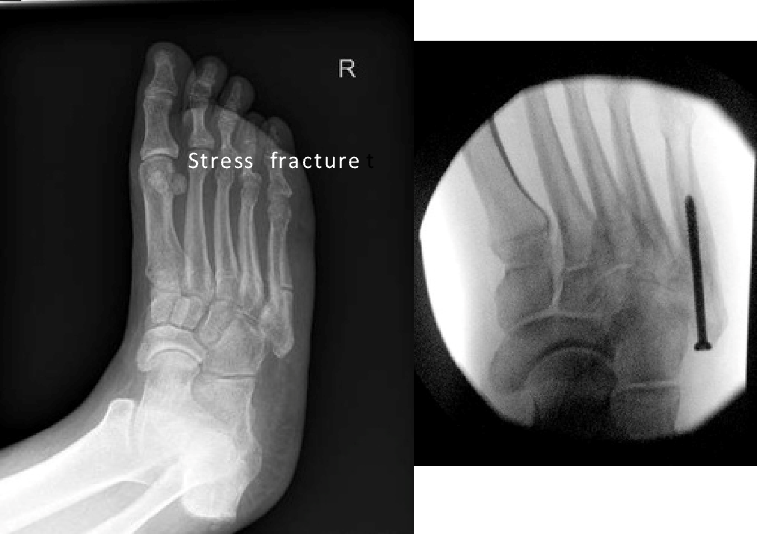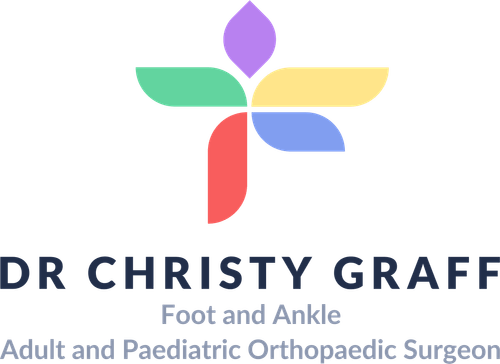5th Metatarsal Fracture Fixation Surgery
What is the 5th Metatarsal Fracture Fixation Surgery?
The 5th metatarsal is the long bone on the foot's outer side that connects to the small toe. Fractures of this bone are common, especially in athletes, dancers, and individuals with high-impact foot injuries. These fractures can range from stress fractures to traumatic breaks.
5th metatarsal fracture fixation surgery is a procedure designed to repair and stabilise fractures of this bone. The goal of the surgery is to align the fractured bone, secure it with surgical hardware (such as screws, plates, or wires), and promote proper healing. This procedure is typically recommended when non-surgical treatments, such as casting or bracing, are insufficient or when the fracture is severe (e.g., displaced fractures or Jones fractures, which occur at the base of the 5th metatarsal and are prone to poor healing).

Who is Suitable for 5th Metatarsal Fracture Fixation Surgery?
This surgery is suitable for individuals who meet one or more of the following criteria:
- Severe or Displaced Fractures: When the broken bone fragments are significantly misaligned and cannot heal properly without surgical intervention.
- Jones Fractures: These occur near the base of the 5th metatarsal and are notoriously slow to heal due to limited blood supply in that area.
- Chronic Non-Union Fractures: When a fracture has not healed adequately after initial non-surgical treatment.
- High-Impact Lifestyle: Athletes or individuals whose activities place high stress on the foot may require surgery to ensure faster and stronger healing.
- Persistent Pain or Functional Limitations: If conservative treatments fail and the patient experiences ongoing pain, instability, or difficulty walking.
- Stress Fractures: Individuals with stress fractures often benefit from surgical stabilisation as these fractures usually go on not to heal.
Benefits of 5th Metatarsal Fracture Fixation Surgery
The key benefits of this surgery include:
- Enhanced Bone Alignment: Ensures proper alignment of the bone fragments for optimal healing and foot function.
- Faster Recovery: Surgery may promote quicker healing than prolonged immobilisation with casting or bracing.
- Improved Stability: The fixation hardware provides a stable environment for the bone to heal and reduces the risk of further displacement.
- Reduced Risk of Non-Union: Surgery is especially beneficial for high-risk fractures like Jones fractures and stress fractures, where non-surgical methods have a higher failure rate.
- Pain Relief: Properly aligned and stabilised fractures heal more effectively, reducing chronic pain associated with untreated or poorly treated fractures.
- Restoration of Foot Function: Patients regain mobility and strength, allowing them to return to daily activities and, in some cases, high-impact sports.
Types of 5th Metatarsal Fracture Fixation Surgery
The type of surgery performed depends on the location and severity of the fracture. Common types include:
- Intramedullary Screw Fixation: A specialised screw is inserted into the hollow centre (medullary canal) of the 5th metatarsal to stabilise the fracture. This method is often used for Jones fractures and stress fractures and provides strong internal support.
- Plate and Screw Fixation: A small metal plate is attached to the outer surface of the bone, secured with screws. This technique is typically used for complex fractures with multiple fragments.
- Kirschner Wire (K-Wire) Fixation: Thin wires are inserted to hold the bone fragments together. This method is often used for less severe fractures or in pediatric patients.
- Bone Grafting: A bone graft may promote healing and provide additional support in cases of chronic nonunion or significant bone loss.
- External Fixation: This procedure involves attaching a stabilising frame outside the foot and is rarely used. It is typically reserved for severe or open fractures with significant soft tissue injury.
Alternative Options to 5th Metatarsal Fracture Fixation Surgery
Surgery might not be immediately necessary in some cases, and conservative treatments can be considered. These alternatives include:
- Immobilisation: Using a cast, walking boot, or splint to immobilise the foot, allowing the fracture to heal naturally. Effective for non-displaced or minimally displaced fractures.
- Weight-Bearing Restrictions: Limiting or avoiding weight-bearing activities to reduce stress on the fractured bone and prevent further damage.
- Physiotherapy: Once the bone begins to heal, therapy may help restore strength, range of motion, and function without surgical intervention.
- Bone Stimulators: A device that uses low-intensity ultrasound or electrical stimulation to promote bone healing, particularly in cases of stress fractures or delayed healing.
- Pain Management: Medications like non-steroidal anti-inflammatory drugs (NSAIDs) or acetaminophen can manage pain during healing.
- Activity Modification: To allow natural healing, avoid activities that aggravate the injury, such as running or jumping.
While these options may work for minor fractures, severe or unstable fractures may still require surgical fixation for optimal recovery.
Preparation Before a 5th Metatarsal Fracture Fixation Surgery
Preparation is critical to ensure a smooth surgical experience and recovery. Steps include:
- Medical Evaluation: A thorough evaluation by Dr Graff, including physical examination, X-rays, and/or CT/MRI scans, to determine the fracture’s severity.
- Pre-Surgery Testing: Blood tests, imaging studies, and other tests may be required to assess overall health and ensure fitness for anesthesia.
- Stop Certain Medications: As advised, discontinue blood-thinning medications (e.g., aspirin or warfarin) to reduce the risk of bleeding during surgery.
- Fasting: Follow your surgeon's instructions on fasting before surgery, typically 6-12 hours.
- Arrange Transportation and Support: Since you will likely be unable to walk comfortably after surgery, arrange for transportation and ensure someone can assist you post-operatively.
Pre-Surgery Planning:
- Discuss medications with Dr Graff, as some may need to be paused (e.g., blood thinners).
- Plan for mobility aids like crutches, a knee scooter, a wheelchair, or a walker for recovery.
- Arrange for help at home, as mobility will be limited after surgery.
- Lifestyle Adjustments:
- Stop smoking, as it can delay bone healing.
- Maintain a healthy weight to reduce stress on the foot during recovery.
- Strengthen leg muscles with exercises recommended by a physiotherapist
- Preoperative Instructions:
- Follow fasting guidelines, avoiding food and drinking 8–12 hours before surgery.
- Prepare your home with accessible essentials and ensure a safe environment for recovery. You will need a plastic shower chair and bags to keep the feet clean and dry.
5th Metatarsal Fracture Fixation Surgery
- Most 5th metatarsal fractures can be fixed with a screw placed inside of the metatarsal using a small incision.
- Other fractures need a bigger incision to fix with a plate and screws or align the bones
- In chronic non-healing fractures, a bone graft is sometimes required to help with healing
- Other surgeries sometimes require changing the foot biomechanics (see Cavovarus Foot Surgery).
- Xrays are used in theatre to make sure the bones are aligned correctly, and there is a tourniquet placed around the thigh to help limit bleeding
The Hospital Stay
- You will wake up with a moonboot or a cast
- Your foot should be elevated
- You will either need blood-thinning medications and vitamin C daily for 6 weeks.
- You will stay in the hospital for 1 day (some patients go home the same day)
- You will be only allowed to touch your foot to the ground for 6 weeks
- Depending on your balance and strength, you may need rehabilitation post-operatively
- Buying a second-hand knee scooter pre-operatively (you can search online) and practising at home before the surgery can be helpful; please bring it into the hospital with you. It is easier to use a knee scooter than crutches.
When You Go Home
- You will need medications for pain relief; regular paracetamol (2 tablets four times a day) is recommended, as well as strong painkillers, especially at night before bed. These can have side effects of drowsiness, nausea and constipation, and other tablets to help with these side effects may be required.
- You will need blood thinners to prevent blood clots and vitamin C daily for 6 weeks.
- You will need a shower chair and bags to keep the moonboot dry for the first 2-3 weeks.
- You will need to attend your post-op appointment in 2-3 weeks, where the wounds will be checked.
- After this, you can shower with a shower chair out of the boot.
Rehabilitation
All patients are different, and these timelines are only guides; some may progress faster or slower than others.
0-3 weeks
- You will be in a moonboot for 2-3 weeks; please treat this like a plaster and do not remove it.
- You can only touch your foot to the ground for balance.
- Please keep your foot elevated and out of bed for toilet only
- You will need to bag the leg for showers
- Pain relief: Please take regular paracetamol with meals and before bed; stronger painkillers are often needed, especially before bed.
- Please take blood thinners and vitamin C as prescribed.
2-3 weeks
- Post-op appointment with Dr Graff: dressings are changed, and an x-ray is taken
- You can then take the foot out of the boot for showers and bed
- You may be able to start static strengthening and range of motion exercises with physio, depending on the xrays
- You can shower normally
6 weeks
- You will have an appointment with Dr Graff and an x-ray
- You can start progressive weight bearing in a boot over 6 weeks, starting with crutches
3 months
- You will have another appointment with Dr Graff and an x-ray;
- You can start weight bearing without the boot and increased strengthening
- You will still have ongoing swelling, but you can wear normal shoes if you can fit into them (supportive sneakers are best)
- You can start swimming and cycling and increase sports-specific training
6 months
- You will have another appointment with Dr Graff and an X-ray
- You will be feeling more ‘yourself’ and improved pain relief in the foot
- If the fracture is healed, you may be discharged
- Sometimes, the metalwork can irritate people and can be removed as a day-case procedure once the fracture has healed.
When Can I Return To Work?
- Seated work at 2-3 months
- Prolonged standing 3-6 months
- Heavy labour work 6-12 months
When Can I Drive?
- Left foot 3 weeks (if driving an automatic car)
- Right foot 6-8 weeks
5th Metatarsal Fracture Fixation Surgery Risks
- Anaesthetic problems
- Nerve injury
- Blood clots
- Infection
- Stiffness
- The fracture does not heal
- The fracture heals in the wrong position
- Ongoing pain
- The need for further surgery
5th Metatarsal Fracture Fixation Surgery Prognosis
The prognosis after 5th metatarsal fracture fixation surgery is generally very good, with most patients returning to normal activities within a few months. Key factors influencing the prognosis include:
- Healing Time: Bone healing typically takes 6-8 weeks. Full recovery, including regaining strength and mobility, may take 3-6 months.
- Functional Recovery: Most patients experience excellent restoration of foot function, especially if they adhere to post-operative care instructions.
- Return to Activities: Athletes and active individuals can often return to sports or high-impact activities after Dr Graffgives clearance, typically 4-6 months after surgery.
- Complication Rates: The risk of complications, such as infection, hardware irritation, or delayed healing, is relatively low.
- Long-Term Outlook: With proper care, the repaired bone remains stable, and most patients have no long-term limitations or chronic pain.
What if 5th Metatarsal Fracture Fixation Surgery is Delayed?
Delaying surgery for a 5th metatarsal fracture can have several potential consequences, depending on the type and severity of the fracture:
- Increased Risk of Non-Union
- Malunion
- Persistent Pain and Swelling
- Reduced Mobility and Function
- Increased Risk of Arthritis
- Complicated Surgery
If surgery is recommended, addressing the fracture promptly increases the likelihood of a successful outcome and minimises complications.
Contact Us
If you want more information or have any questions or problems, please contact Dr Graff at admin@christygraff.com or call the rooms at 0493 461 133.
